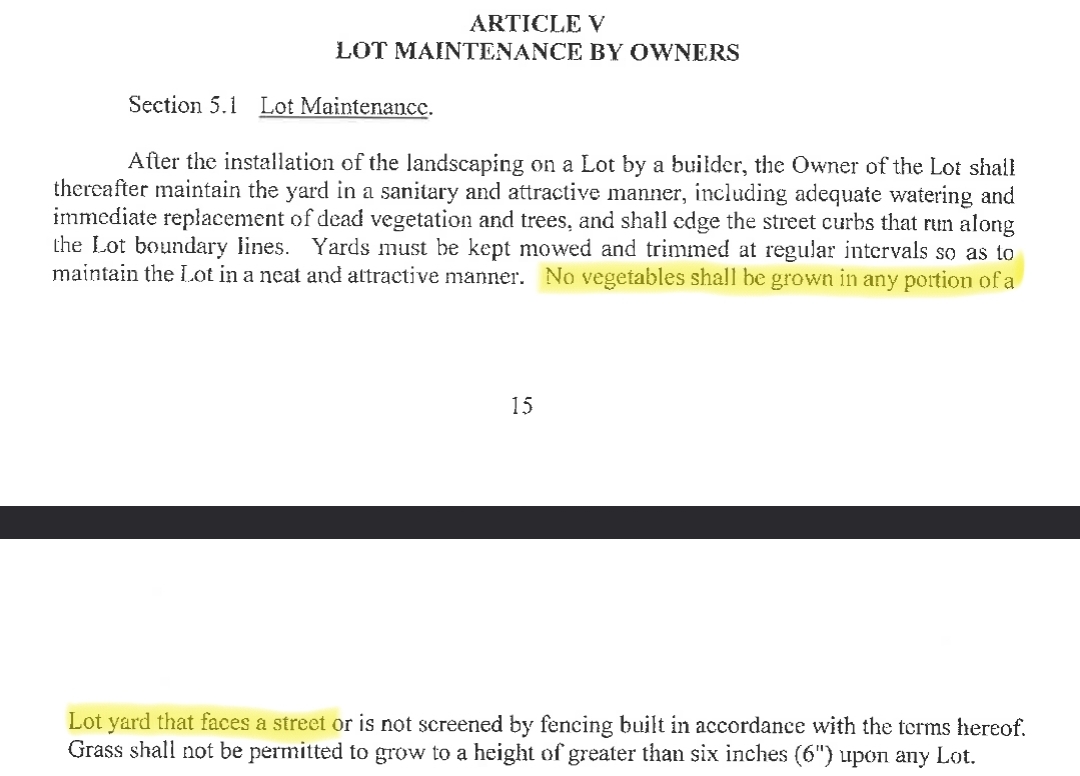Why don't Americans plant trees and bushes of stuff that they can eat in their houses instead of having useless grass?
-
I’m tryin’, man. Fruit bearing plants take a lot of work compared to the manicured suburban steriscape. They’re not super easy to grow (depending on where you live), require pruning and fertilizer, soil amendment, and unfortunately pesticides or fencing if you don’t want insects or deer destroying your hard work.
That’s way more effort than most people want to expend. HOAs or even local ordinances may also restrict what can be grown.
European garden with some ten different berries/fruit trees and bushes - no work needed, they just do their thing (when they are big enough.) Rotate about one every three years, sometimes move some berries from one place to another.
Strawberries are a ton of work at the end of the year (not the little wild ones though,) don't do them unless you really love them.
-
This post did not contain any content.
You’re talking about a country that has no universal healthcare, record gun violence, divisive civil political unrest, low education and health compared to other developed countries, record wealth inequality, lies and propaganda coming from their federal government, policies that attack allies and work with dictatorships… and people are wondering why they can’t plant trees instead of grass?
-
HOAs say “ew no that’s for the poors” and good luck finding a house that’s not in an HOA within a reasonable commute to your job
...pretty much this: you'll be fined for anything other than well-groomed grass growing in your yard...
-
This post did not contain any content.
In, or in the yard of?
If you mean in the yard of their houses, it goes back to the days of aristocracy. Having land you don't use for food was a form of conspicuous consumption, and you had sports grow up around stretches of short grass as a result, like golf and polo. The former is still synonymous with the well-off, even.
Then you have to skip ahead to the 1960's in America, where the "mid-century modern" philosophy of urban planning gains prominence. The idea was to get people out of the crowded, Victorian-style slums - which we might find quaint in hindsight, but at the time were very stigmatised. This extended to a certain disdain for cities and buildings in general, even - more nature was better. So, where do you put people? In tiny little rural estates modeled on the ones popular with aristocrats, separated by zoning laws from the other sections of the city.
The vision was that people would get home from their 9-5 jobs in the commercial-only zones in their very own car, and would hang out outside enjoying their government-mandated leisure time. The urban planners of the time probably pictured a giant croquet course going up and down a residential street, and the all-white 3.5 kid families that live there sitting outside on lawn chairs, playing friendly games against each other. These "white picket fence" suburbs had lawns, then, because you couldn't have semi-rural domestic bliss without them, according to architects who graduated Harvard in 1920.
In practice, of course, none of that happened. Like so many other tidy ideas it failed to predict how the general public would interact with it. I've been to plenty of places like that. You know the names of your neighbor, but not much else about them, and the people a few doors down are suspect of being pedophiles or violent drug dealers. That fence line is sacred, each house becomes an island, and you're frightfully dependent on driving to get anywhere you can do basic errands. And that's not even getting into the racial issues that came out of it.
Now, in the 21st century, people assume houses have always had lawns, and messing with that formula irritates the local NIMBYs. New ideas become rigid tradition, and it falls to the next generation to question them. Hopefully we will, but it will take a moment.
-
HOAs say “ew no that’s for the poors” and good luck finding a house that’s not in an HOA within a reasonable commute to your job
My HOA:

-
This post did not contain any content.
Bugs, pests, and animals, at least where I live. Unless you build a green house, clear the yard of all other foliage, or somehow fortify your garden, only produce with natural defenses like peppers will make it to harvest. However, I am jealous of my friends on the west coast, who don't really have to worry about bugs or other critters eating from their fruit trees just passively growing in their yard.
-
This post did not contain any content.
Some do. Grass just got into the pop culture as the "proper" look for a residential property. But having fruit trees is amazing, especially in spring when they are all in bloom with flowers.
-
Bugs, pests, and animals, at least where I live. Unless you build a green house, clear the yard of all other foliage, or somehow fortify your garden, only produce with natural defenses like peppers will make it to harvest. However, I am jealous of my friends on the west coast, who don't really have to worry about bugs or other critters eating from their fruit trees just passively growing in their yard.
If you're East Coast, I think you've just given up too early. Plenty of pests on the West Coast, too. There are also plenty of organic ways to keep them in check. Will you have perfect harvest? Never, but that doesn't mean you can't have anything at all.
-
So front yard? Yeah, not super surprised at that. I’ve heard plenty of stories about front yard cultivators running into problems with the city. I live in a more rural/urban mixed area so it’s a lot more forgiving. Plenty of people here have apples or other fruit trees in the front yard - not aggressively farming the yard, just as part of the plantings.
Ya front yard. We didn’t aggressively plant either. We had 4 or 5 fruit trees planted with beds around them
-
This post did not contain any content.
-
In, or in the yard of?
If you mean in the yard of their houses, it goes back to the days of aristocracy. Having land you don't use for food was a form of conspicuous consumption, and you had sports grow up around stretches of short grass as a result, like golf and polo. The former is still synonymous with the well-off, even.
Then you have to skip ahead to the 1960's in America, where the "mid-century modern" philosophy of urban planning gains prominence. The idea was to get people out of the crowded, Victorian-style slums - which we might find quaint in hindsight, but at the time were very stigmatised. This extended to a certain disdain for cities and buildings in general, even - more nature was better. So, where do you put people? In tiny little rural estates modeled on the ones popular with aristocrats, separated by zoning laws from the other sections of the city.
The vision was that people would get home from their 9-5 jobs in the commercial-only zones in their very own car, and would hang out outside enjoying their government-mandated leisure time. The urban planners of the time probably pictured a giant croquet course going up and down a residential street, and the all-white 3.5 kid families that live there sitting outside on lawn chairs, playing friendly games against each other. These "white picket fence" suburbs had lawns, then, because you couldn't have semi-rural domestic bliss without them, according to architects who graduated Harvard in 1920.
In practice, of course, none of that happened. Like so many other tidy ideas it failed to predict how the general public would interact with it. I've been to plenty of places like that. You know the names of your neighbor, but not much else about them, and the people a few doors down are suspect of being pedophiles or violent drug dealers. That fence line is sacred, each house becomes an island, and you're frightfully dependent on driving to get anywhere you can do basic errands. And that's not even getting into the racial issues that came out of it.
Now, in the 21st century, people assume houses have always had lawns, and messing with that formula irritates the local NIMBYs. New ideas become rigid tradition, and it falls to the next generation to question them. Hopefully we will, but it will take a moment.
Thanks, you explained better than I would have. I was going to go on a tangent about Louis XIV showing the other aristocrats his new "lawn" concept.
-
Ya front yard. We didn’t aggressively plant either. We had 4 or 5 fruit trees planted with beds around them
That really sucks.
-
Ok, but why?
Because of 18th century French aristocracy, no shit.
-
My HOA:

Looks like you are stuck with fruits, grains, herbs, and ornamentals in the front yard, then, lol.
-
I mean some of us hate grass so much we started a huge reddit community about it that made it's way too lemmy.
-
This post did not contain any content.
Why aren't people everywhere?
-
This is why:
https://youtu.be/EwVovJgwbJQAI summary, for those who can't watch it right now, like myself:
The video discusses the history of lawns and their impact on American culture:
-
Lawns originated in 17th century Europe as a symbol of wealth and status, eventually making their way to America [01:31].
-
The invention of the push lawnmower and sprinklers in the 19th century made lawn maintenance more accessible [02:43].
-
After World War II, suburban sprawl and consumerism led to lawns becoming a standard feature of the American dream [03:37].
-
Homeowners' associations (HOAs) enforce strict rules about lawn care, contributing to the pressure to maintain a perfect lawn [05:23].
-
The lawn care industry has become a massive business, with homeowners spending billions of dollars on products and services [07:14].
-
Lawns have negative environmental impacts, including water waste and pesticide runoff [09:11].
-
The video suggests alternatives to traditional lawns, such as growing food or native species, xeriscaping, using fake turf or clover, or simply letting the lawn grow naturally [10:13].
-
-
Ok, but why?
The real answer is because in America rich people buy houses, and then create HOAs in the housing deeds and contracts to force all future owners to maintain the house in a way that will increase the neighborhood property value forever.
HOAs exclusively fight to make houses more and more "valuable" since housing is a financial investment here
-
This post did not contain any content.
As someone who lives in an ex-industrial city (Birmingham Alabama), I’ve always been worried about air pollution and tainted soil (there are superfund sites nearby). I feel like every thing would have to be above ground and covered. That seems like a lot of work. Should I be worried?
-
Thanks, you explained better than I would have. I was going to go on a tangent about Louis XIV showing the other aristocrats his new "lawn" concept.
Hey, thanks!
I have to point out, Versailles did have quite a bit of lawn and certainly helped, but the concept of decorative short grass predates it, and even existed in the some of the American civilisations using a totally different plant IIRC. The Wikipedia article notes several medieval examples.


